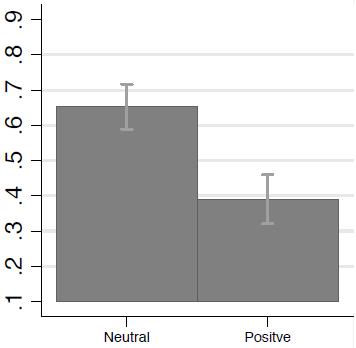Are happy people more cooperative? Understanding how good mood affects productivity
Happy people may be more productive - but can they work together? Results from recent laboratory experiments suggest that while good mood will normally boost workplace productivity, this might be blunted when cooperation with others is a vital feature of the job, writes Professor Daniel Sgroi from Warwick's Department of Economics in an article first published in Advantage Magazine.
We know that investment in mental health and wellbeing at work can improve productivity. In 2017 the UK government published an independent review of mental health and employers which supported wellbeing improvements at work as a means to boost productivity (Stevenson and Farmer, 2017). A Deloitte report published as part of the review found that investment in workplace mental health and wellbeing gives an average return of 4.21:1 on any money invested, and anything up to 9:1 is possible (Hampson et al. 2017).
Do happy workers work harder?
But what effect can interventions to improve general mood at work have on productivity? Do workers in a good mood work harder? In a series of studies, we looked at simple ways businesses might improve mood in the workplace, and the effect this might have on productivity. Our methods were often quite straightforward and cheap to make operational: even just showing people a ten minute comedy clip had a powerful effect on productivity. But some of our most recent work provides a more complex story that reveals when a good mood can be very effective at boosting productivity and when it might be less effective.
In one study (Oswald et. al., 2015) we recruited more than 500 subjects in a laboratory experiment to complete a simple task (adding as many numbers together as they could in a tight time limit) and paid them based on the number of problems they solved correctly. We showed the workers a movie before they undertook the task: either one designed to make them feel happy; or a placebo ‘neutral’ clip. Alternatively, we provided them with free fruit or water.
Those who witnessed the mood-boosting clip or were given fruit or water were significantly more productive (10-12%), putting in greater effort (answering more questions) while maintaining the same error rate – so they produced more correct answers and were paid more. We also replicated our findings using real-world happiness shocks; finding that subjects who had suffered losses in their close family up to five years earlier were around 10% less productive.
What about teamwork?
Our results seemed to reinforce the expectation that good mood improves productivity at work. Nevertheless, we worried we might be missing negative aspects of mood. The problem with our 2015 design was that the workers were on their own. What about team-based work where cooperation is important? Would good mood also increase cooperation?
In another experiment (Proto et. al., 2017), we hired another 490 laboratory subjects to play a repeated Prisoner’s Dilemma: possibly game theory’s most well-known social dilemma. Subjects face a classic trade-off: cooperate with the other player, and if both cooperate then there is scope for a big return (but a failed attempt to cooperate is very damaging); or go for the best individual payoff, which is smaller than the joint payoff, but much safer (with no need to trust anyone).
Decades of laboratory experiments and fieldwork tell us that although economics predicts selfish ‘individual optimisation’ (a failure to cooperate) people do in fact cooperate quite well. But we are not quite sure why or when they will do so. The aim of our experiment was to see if mood might help provide some insight. At the same time, by examining a repeated Prisoner’s Dilemma, we could explore the role of mood in tasks that require interaction and repetition.
Once again, we induced different mood into different groups of people, using movie clips, music and mood-boosting statements. We allowed players to chat with each other because that is how people coordinate in most real-world settings.
Happy but less cooperative
Much to our surprise, we found that happier people cooperate significantly less. Figure 1 indicates an almost 65% cooperation rate in the neutral movie clip setting compared to under 40% with the positive mood-inducing movie clip (and we found similar numbers using our alternative forms of mood induction). This also means lower profits for happier people since cooperation, while risky, is where the best payoffs were to be found.

Figure 1: Cooperation rates under neutral and positive mood induction (movie clip method)
To find out what was going on, we collected data on the words people used when they communicated with each other. We discovered that happier individuals (who faced our positive mood induction procedures) seemed more inward-oriented: they used words like ‘I’ much more than the neutral group. Second, they appeared to use more negative language, focusing on negative comments when communicating with others. This is consistent with previous work in neuroscience suggesting that happier people are prone to use less information and be more self-oriented. There are many reasons why this might be the case: perhaps the most obvious is that if you are very happy then you have more to lose, and so risking everything by trusting in others to cooperate is potentially more costly.
Putting this all together, it seems that simple interventions to boost mood in the workplace might be a good idea when trust and cooperation are less important than individual productivity: this might be common in factories, offices, call centres and in many other forms of employment. But if teamwork involving the need for cooperation and trust is more important, then mood-boosting practices might be less valuable. Of course, most jobs include elements of both independent and cooperative work and so close scrutiny of their relative importance will turn out to be crucial when thinking about the role of mood in the workplace.
Further reading
Oswald, A.J., Proto, E., and Sgroi, D. (2015), ‘Happiness and productivity’, Journal of Labor Economics, 33(4): 789-822.
Proto, E., Sgroi, D., and Nazneen, M. (2017), ‘The effect of positive mood on cooperation in repeated interaction’, CAGE working paper no. 347.
References
Hampson, E., Soneji, U., Jacob, A., Mecu, B., and Mc Gahan, H. (2017), Mental health and employers: The case for investment: Supporting study for the Independent Review, Deloitte.
Stevenson, D., and Farmer, P. (2017), Thriving at Work: The Stevenson/Farmer review of mental health and employers.
Published:
5 November 2019
About the author:
 Daniel Sgroi is Professor of Economics at the University of Warwick specialising in behavioural economics, experimental economics and economic theory. His early work covered learning and games, with applications to industrial organisation and finance. More recently he has been working at the borders with psychology, to understand how psychological traits, cognitive biases, mood, language and beliefs affect behaviour.
Daniel Sgroi is Professor of Economics at the University of Warwick specialising in behavioural economics, experimental economics and economic theory. His early work covered learning and games, with applications to industrial organisation and finance. More recently he has been working at the borders with psychology, to understand how psychological traits, cognitive biases, mood, language and beliefs affect behaviour.
Advantage Magazine:
This article first appeared in the Autumn 2019 edition of Advantage, the magazine of the ESRC-funded Centre for Competitive Advantage in the Global Economy.
Click on the image to see the latest issue of Advantage.
Terms for republishing
The text in this article is licensed under a Creative Commons Attribution 4.0 International License (CC BY 4.0).
Share



